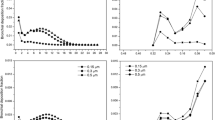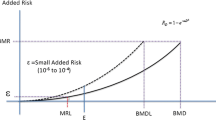Abstract
Mathematical models predicting tissue doses of chemical toxicants can be either highly complex or simple, depending upon the end results needed. As an example of a highly complex mathematical model, the Miller Model of the distribution of reactive gases in human and animal lungs is described. The Miller Model accounts for the convection, the radial and axial diffusion, and the chemical reactions of gases as an inhaled breath passes down the airways. The geometry and physiology of human and animal lungs are used to calculate the convection and diffusion likely in each generation or bifurcating series of airways commencing with the trachea and extending 24 generations in humans. The chemical reactivity of ozone, an air pollutant, is accounted for by simulating second-order chemical reactions with the fluid lining materials of the lung and tissue biological molecules. The flux of ozone into three compartments (pulmonary tissue, overlying liquid layer and capillary blood) in each generation of the lung is calculated to provide molecular doses of ozone reaching each region of the lung. These results of calculated molecular dose are then used to construct dose-response curves for a variety of biological endpoints.
A much simpler model is also described which recognizes the saturable or Michaelis-Menten type of kinetics controlling the removal of nickelous ion (nickel) from the lung. This model is used to calculate the chronic lung burden of the human lung for occupational, environmental and cigarette smoking exposure scenarios.
In both the complex Miller Model and the simpler nickel lung burden model, the results can be used to calculate molecular doses at the potential site of action of these environmental chemicals and to unify a wide variety of studies. The predictions made are more likely to be valid since multiple investigators using a variety of animal species have participated in generation of the primary data. As a methodology, mathematical modeling based on physiological, physicochemical and anatomical principles provides a means of eliminating non-scientific considerations from the important process of regulating and recognizing toxic or cancer causing chemicals in the human environment.
Similar content being viewed by others
Literature
American Conference of Governmental Industrial Hygienist (ACGIH). 1979. “Threshold Limit Values for Chemical Substances in Workroom Air adopted by ACGIH for 1979.” Cincinnati OH: ACGIH.
Boysen, M., L. A. Solberg, W. Torjussen, S. Popper and A. C. Hogetveit. 1984. “Histological Changes, Rhinoscopical Findings and Nickel Concentration in Plasmas and Urine in Retired Nickel Workers.”Acta otlar. 97, 105–115.
Castleman, W. L., W. S. Tyler and D. L. Dungworth. 1977. “Lesions in Respiratory Bronchioles and Conducting Airways of Monkeys Exposed to Ambient Levels of Ozone.”Expl. molec. Pathol. 26, 384–400.
—, D. L. Dungworth, L. W. Schwartz and W. S. Tyler. 1980. “Acute Respiratory Bronchiolitis. An Ultrastructural and Autoradiographic Study of Epitheilial Cell Injury and Renewal in Rhesus Monkeys Exposed to Ozone.”Am. J. Pathol. 98, 811–840.
Deal, D. L., R. L. Wolpert, M. I. Tayyeb, J. R. Boger, J. E. Valentini and D. B. Menzel. 1986. “Pharmacokinetics of Nickel Aerosols in Rats.” (In Preparation.)
Environmental Protection Agency (EPA). 1978. “Toxicological Appraisal of Photochemical Oxidants.” InAir Quality Criteria for Ozone and Other Photochemical Oxidants, Chap. 8, pp. 136–199. Washington DC: U.S. Government Printing Office.
Eustis, S. L., L. W. Schwartz, P. C. Kosch and D. L. Dungworth. 1981. “Chronic Bronchiolitis in Nonhuman Primates after Prolonged Ozone Exposure.”Am. J. Pathol. 105, 121–137.
Francovitch, R. J., C. R. Shoaf, M. I. Tayyeb and D. B. Menzel. 1986. “Modeling Nickel Dosimetry From Kinetic Measurements in Rats.” (In preparation.)
Gunther, B. (1985). “Dimensional Analysis and Theory of Biological Similarity.”Physiol. Rev. 55, 659–699.
Menzel, D. B. and F. J. Miller. 1984. “Ozone: an Overview of its Toxicity in Man and Animals.” InFundamentals of Extrapolation Modeling of Inhaled Toxicants, F. J. Miller and D. B. Menzel (Eds). New York: Hemisphere.
— and R. O. McClellan. 1985. “Inhalation Toxicology.” InToxicology: the Basic Science of Poisons, J. Doull, M. O. Amdur and C. D. Klassen (Eds). New York: Macmillan.
Menzel, D. B., R. L. Wolpert, C. R. Shoaf and D. L. Deal. 1986. “Predicting Human Lung Burdens of Soluble Nickel Salts.” InProc. Second U.S. Dutch Conference on Air Pollution: Aerosols, L. Grant and T. Schneider (Eds), (in press).
Michaelis, L. and M. L. Menten. 1913. “Die Kientik der Invertwirkung.”Biochem. Z. 49, 333–369.
Miller, F. J., D. B. Menzel and D. L. Coffin. 1978. “Similarity Between Man and Laboratory Animals in Regional Pulmonary Deposition of Ozone.”Envir. Res. 17, 84–101.
—, J. H. Overton, Jr., R. H. Jaskot and D. B. Menzel. 1985. “A Model of the Regional Uptake of Gaseous Pollutants in the Lung. 1. The Sensitivity of the Uptake of Ozone in the Human Lung to Lower Respiratory Tract Secretions and Exercise.”Toxicol. appl. Pharmac. 79, 11–27.
Plopper, C. G., C. K. Chow, D. L. Dungworth and W. S. Tyler. 1979. “Pulmonary Alterations in Rats Exposed to 0.2 and 0.1 ppm Ozone. A Correlated Morphological and Biochemical Study.”Archs envir. Hlth 34, 390–395.
Smolko, E. D., D. J. McKee and D. B. Menzel. 1986. “Critical Toxicity Reference System. I. An Approach for Managing Quantitative Toxicity Data.”J. Am. College Toxicol.
Author information
Authors and Affiliations
Rights and permissions
About this article
Cite this article
Menzel, D.B., Wolpert, R.L. Chemical carcinogenesis and toxicity models: Matching complexity to objectives. Bltn Mathcal Biology 48, 293–307 (1986). https://doi.org/10.1007/BF02459683
Issue Date:
DOI: https://doi.org/10.1007/BF02459683




